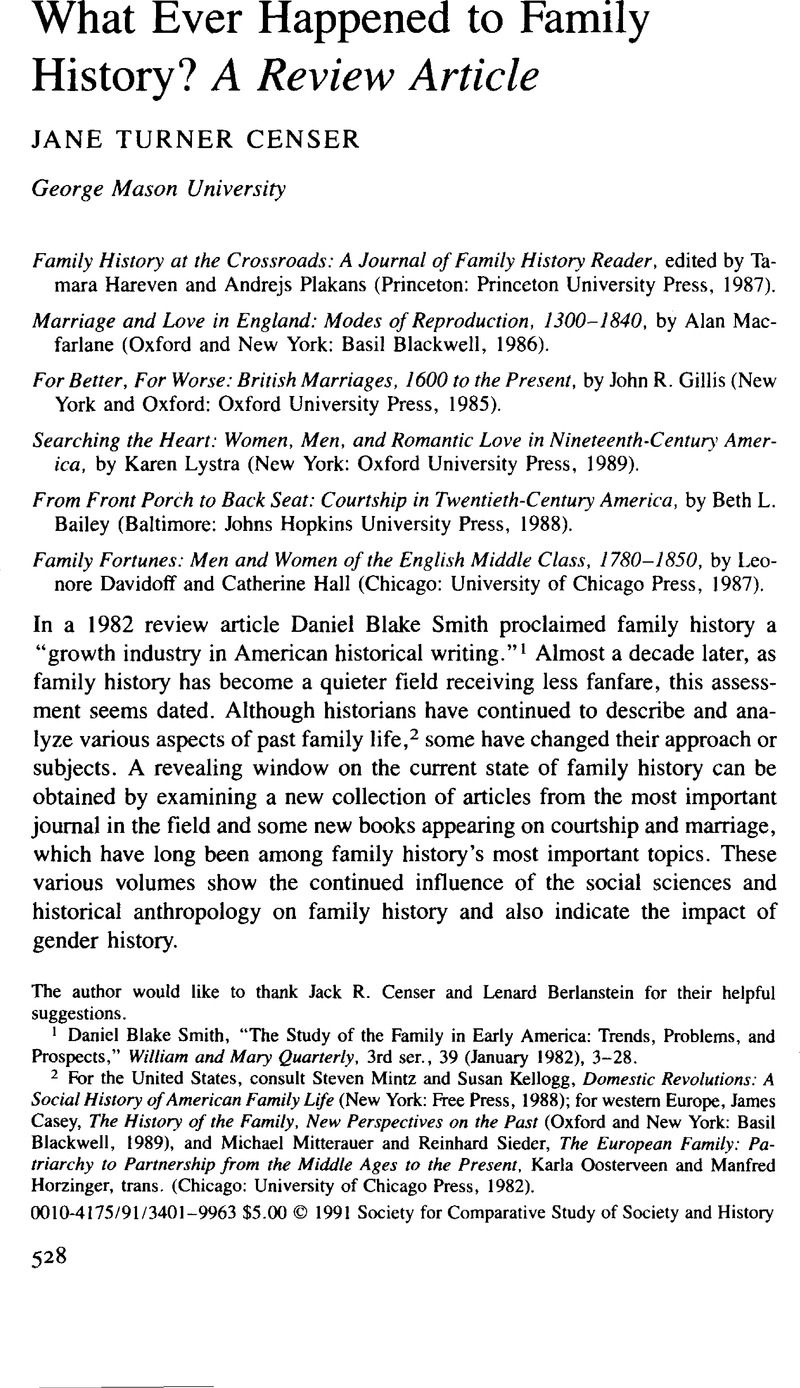Article contents
What Ever Happened to Family History? A Review Article
Published online by Cambridge University Press: 03 June 2009
Abstract

- Type
- Acts of Kinship
- Information
- Copyright
- Copyright © Society for the Comparative Study of Society and History 1991
References
1 Blake Smith, Daniel, “The Study of the Family in Early America: Trends, Problems, and Prospects,” William and Mary Quarterly, 3rd ser., 39 (01 1982), 3–28.CrossRefGoogle Scholar
2 For the United States, consult Mintz, Steven and Kellogg, Susan, Domestic Revolutions: A Social History of American Family Life (New York: Free Press, 1988);Google Scholar for western Europe, Casey, James, The History of the Family, New Perspectives on the Past (Oxford and New York: Basil Blackwell, 1989),Google Scholar and Mitterauer, Michael and Sieder, Reinhard, The European Family: Patriarchy to Partnership from the Middle Ages to the Present, Oosterveen, Karla and Horzinger, Manfred, trans. (Chicago: University of Chicago Press, 1982).Google Scholar
3 In particular, see Smith, “Study of the Family” 3–28; Ryan, Mary, “The Explosion of Family History,” Reviews in American History, 10 (12 1982), 181–95;CrossRefGoogle ScholarStone, Lawrence, “Family History in the 1980s: Past Achievements and Future Trends,” Journal of Interdisciplinary History, 12 (Summer 1981), 51–87;CrossRefGoogle Scholar and Mintz, Stephen, A Prison of Expectations: The Family in Victorian Culture (New York and London: New York University Press, 1983), 1–10.Google Scholar
4 Macfarlane, Alan, The Origins of English Individualism: Family, Property and Social Transition (Cambridge: Cambridge University Press, 1978).Google Scholar
5 This has been true for other areas of family history. See, for example, some of the recent work on family violence and child welfare such as Gordon, Linda, Heroes of Their Own Lives: The Politics and History of Family Violence (New York: Viking Penguin, 1988);Google ScholarPleck, Elizabeth, Domestic Tyranny: The Making of American Social Policy against Family Violence from Colonial Times to the Present (New York: Oxford University Press, 1987).Google Scholar
6 Stowe, Steven, Intimacy and Power in the Old South: Ritual in the Lives of the Planters (Baltimore and London: Johns Hopkins University Press, 1987),Google Scholar chs. 2 and 5, explores courtship both from the perspective of gender history and from internal and external views.
7 This subject takes us into the burgeoning field of the history of sexuality. For the lack of sexual fulfillment, see Cominos, Peter, “Innocent Femina Sensualis in Unconscious Conflict,” in Suffer and Be Still: Women in the Victorian Age, Vicinus, Martha, ed. (Bloomington and London: Indiana University Press, 1972), 155–72.Google Scholar For opposing views, see Degler, Carl, “What Ought to Be and What Was: Women's Sexuality in the Nineteenth Century,” American Historical Review, 79 (12 1974), 1467–90,CrossRefGoogle ScholarPubMed and more recently, Gay, Peter, The Education of the Senses, vol. 1, and The Tender Passion, vol. 2 of The Bourgeois Experience, Victoria to Freud (New York: Oxford University Press, 1984, 1986).Google Scholar
8 Rapp, Rayna, Ross, Ellen, and Bridenthal, Renate, “Examining Family History,” Feminist Studies, 5 (Spring 1979), 174–200.CrossRefGoogle Scholar
9 Alan Williams, “The State and the Family in Eighteenth-Century Paris: Toward a Sociology of Spheres” (paper presented at the 8–10 November 1990 meeting of the Western Society French History).
10 Donzelot, Jacques, The Policing of Families, Hurley, Robert trans. (New York: Pantheon, 1979).Google Scholar
- 1
- Cited by


